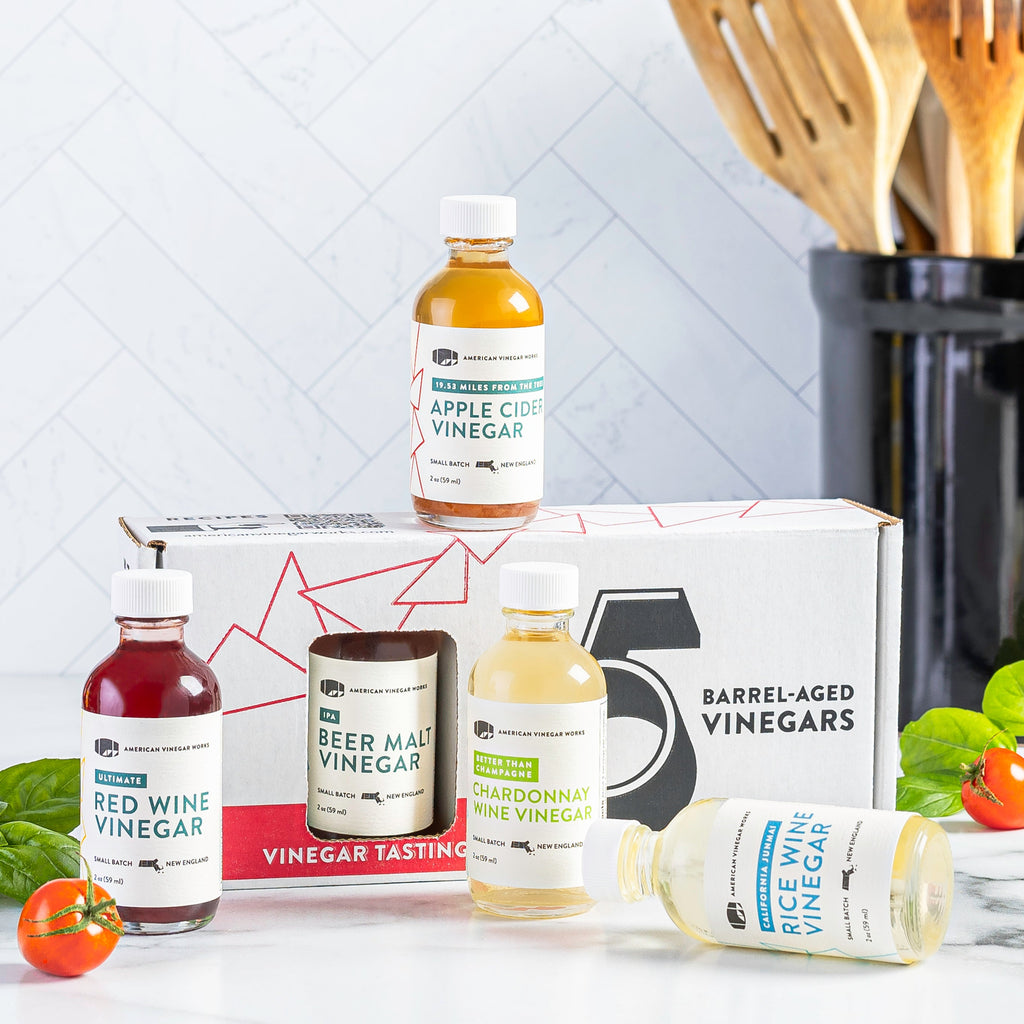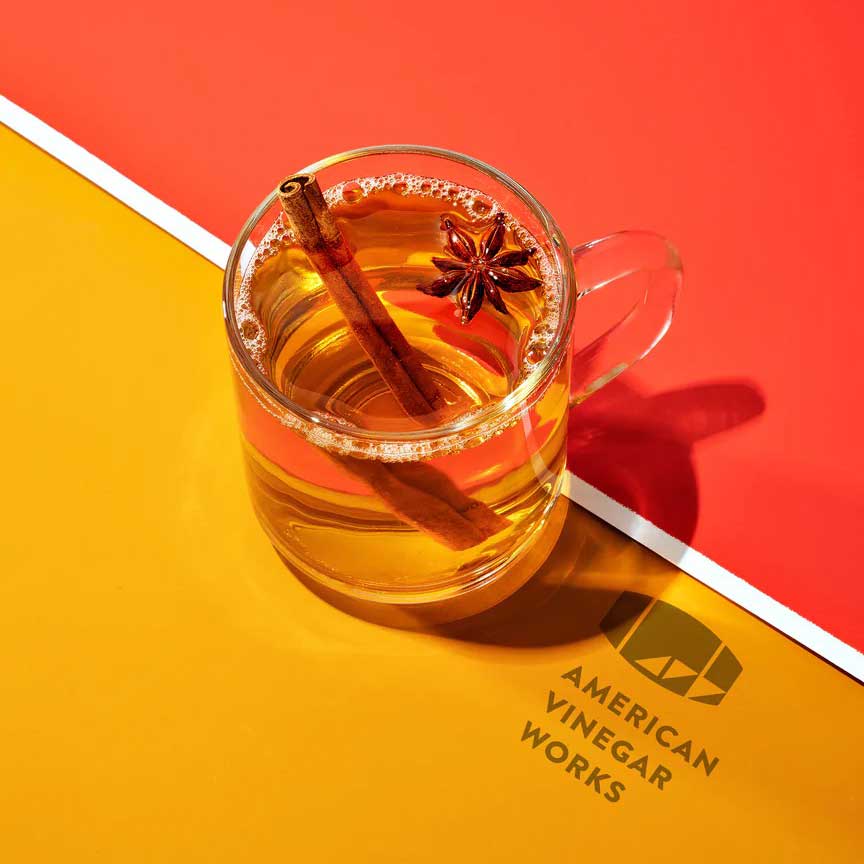
Why this distinction matters
The difference between cleaning vinegar and cooking vinegar is simple but important. One belongs under the sink. One belongs on the plate. Cleaning vinegar is a plain household acid for glass, limescale, and light deodorizing. Cooking vinegar is a crafted food with aroma, balance, and a smooth finish that makes salads, sauces, pan juices, pickles, and roasted vegetables taste complete. We make the second kind with care, from expressive American ciders, wines, and beers, then ferment and mellow with time so the acid reads bright not harsh.
The difference between cleaning vinegar and cooking vinegar in one glance
-
Purpose
Cleaning vinegar is a utility cleaner. Cooking vinegar is an ingredient that carries flavor. -
Production
Cleaning vinegar is made for consistency and low cost. Cooking vinegar is slow fermented, carefully mellowed, and bottled to preserve nuance and finish. -
Aroma and taste
Cleaning vinegar smells one note. Cooking vinegar shows orchard, grain, or nutty notes with a long clean finish. -
Where to store
Cleaning vinegar in the supply closet. Cooking vinegar in the pantry. -
Rule to remember
If it tastes wonderful, cook with it. If it only smells like strong acid, clean with it.
Use cases that make the choice obvious
When to use cooking vinegar
-
Vinaigrettes one part vinegar to three parts olive oil with a pinch of salt
-
Pan finishes deglaze a hot skillet with a teaspoon of sherry or porter style, then swirl in butter or olive oil
-
Quick pickles equal parts rice wine vinegar and water with salt and a little sugar
-
Warm tray finish splash apple cider vinegar on roasted vegetables right off the oven for a glossy, lively plate
When to use cleaning vinegar
-
Glass and mirrors dilute with water and wipe dry
-
Limescale soak fixtures in a one to one mix of water and cleaning vinegar, then rinse
-
Microwave steam clean heat water with a spoon of cleaning vinegar, wipe splatters
-
Laundry rinse a small splash can help with odors in the rinse cycle
Keep them separate so your craft bottle stays dedicated to flavor.
How we craft cooking vinegar so it belongs on your plate
We start with quality American alcohols that carry a sense of place, then run a careful acetic fermentation using a revived drip method first described in 1823. After fermentation, the vinegar rests in used American oak so the edges soften and the finish becomes longer and more complex. We bottle without heavy filtration so the character remains clear. This is not a cleaner. It is a small batch food that makes other foods taste better.
Pick the right cooking vinegar for the job
-
Apple Cider Vinegar everyday anchor for dressings, slaws, and sheet pan finishes
-
Better Than Champagne Chardonnay Wine Vinegar crystal bright for lettuce and seafood
-
American Barrel California Sherry Vinegar calm warm finish for beans, mushrooms, and roasts
-
California Junmai Rice Wine Vinegar silky and floral for quick pickles and noodle salads
-
Ultimate Red Wine Vinegar structured choice for tomatoes and grilled vegetables
-
IPA Beer Malt Vinegar citrus like snap for potatoes, tacos, and slaws
-
Porter Beer Malt Vinegar savory echo for gravies and mushroom pans
If a recipe calls for balsamic and you want to stay in our range, use Apple Cider Vinegar with a small spoon of maple for gentle fruit depth, then reduce briefly for body.
Simple recipes that prove the difference
Every night vinaigrette
-
1 tablespoon Apple Cider Vinegar
-
3 tablespoons olive oil
-
Pinch of salt
Shake until glossy. Greens taste bright and composed.
Mushroom skillet finish
Sauté mushrooms in oil. Splash 2 teaspoons American Barrel California Sherry Vinegar. Swirl in butter and salt. The sauce tastes deep, not sharp.
Crispy potato snap
Toss hot potatoes with 2 teaspoons of IPA Beer Malt Vinegar and flaky salt. Add parsley.
Rice wine quick pickled onions
Equal parts California Junmai Rice Wine Vinegar and water with salt and a little sugar. Chill twenty minutes.
Use cleaning vinegar for windows not recipes.
Safety and storage
-
Never mix any vinegar with bleach.
-
Avoid using cleaning vinegar on natural stone; keep it off marble, limestone, and some granites.
-
Store cooking vinegar cool and capped. Aroma stays bright for months.
-
Keep cleaning vinegar labeled and away from your pantry shelf.
Frequently asked questions
Is cleaning vinegar stronger than cooking vinegar
Cleaning vinegar can be slightly stronger in acid and is not formulated for flavor. Cooking vinegar balances the same acidity with aroma and finishes you actually want to taste.
Can I cook with cleaning vinegar if I am out of the good stuff
No. Keep a spare bottle of small batch cooking vinegar on hand for food. Cleaning vinegar belongs on glass and fixtures.
Why do your vinegars taste softer than the cheap ones
Slow fermentation, barrel mellowing, and unhurried finishing create layered flavor and a smooth finish rather than a one note bite.
Do your vinegars contain alcohol
No. Alcohol is converted during fermentation before bottling.
What makes your vinegar American
We source American ciders, wines, and beers and make everything in central Massachusetts with historic methods and local partners.
Final thoughts
The difference between cleaning vinegar and cooking vinegar comes down to purpose. Cleaning vinegar is a useful household helper. Cooking vinegar is an ingredient that carries history, craft, and flavor to the plate. Keep them in their lanes and dinner will always win. Add Apple Cider Vinegar for your daily dressing, include Sherry Vinegar for warm finishes, and Rice Wine Vinegar for quick pickles. Keep a separate jug of distilled white for chores. Choose fast vinegar delivery and taste the difference in tonight’s salad and skillet sauce.

